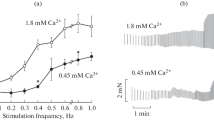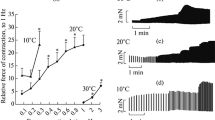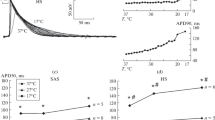Summary
Increasing the frequency of steady state stimulation increases the rate of mechanical restitution in hypothermic (27°C) guinea pig papillary muscles. In this paper we have investigated the influences of the calcium antagonist nifedipine and of reduced extracellular calcium concentration on this phenomenon. We found that nifedipine abolished the frequency dependent increase in the restitution rate, which was also sensitive to extracellular [Ca2+]. These findings suggest that the level of intracellular [Ca2+] can influence the rate of restitution. It is implied that this effect is mediated via ICa, the inward calcium current, which makes a larger than normal contribution to direct contractile activation in hypothermic myocardium.
Similar content being viewed by others
References
Allen DG (1983) The use of isolated cardiac muscle preparations. Techniques in the life sciences Part 3: Cardiovascular Physiology. Elsevier, Amsterdam New York Oxford, pp 1–21
Antoni H (1977) Elementary events in excitation-contraction coupling of the mammalian myocardium. Basic Res Cardiol 72:140–146
Bers DM, Bridge JHB, MacLeod KT (1987) The mechanism of ryanodine action in rabbit ventricular muscle evaluated with Ca-selective microelectrodes and rapid cooling contractures. Can J Physiol Pharmacol 65:610–618
Cooper IC, Fry CH (1990) Mechanical restitution in isolated myocardium: species differences and underlying mechanisms. J Mol Cell Cardiol 22:439–452
Edman KAP, Johannsson M (1976) The contractile state of rabbit papillary muscle in relation to stimulation frequency. J Physiol 254:565–581
Fabiato A (1983) Calcium-induced release of calcium from the cardiac sarcoplasmic reticulum. Am J Physiol 245:C1-C14
Harrison SM, McCall E, Boyett MR (1992) The relationship between contraction and intracellular sodium in rat and guinea pig ventricular myocytes. J Physiol 449:517–550
Henry PD (1980) Comparative pharmacology of calcium antagonists: nifedipine, verapamil and diltiazem. Am J Cardiol 46:1047–1058
Kohlhardt M, Fleckenstein A (1977) Inhibition of the slow inward current by nifedipine in mammalian ventricular myocardium. Naunyn-Schmiedeberg's Arch Pharm 298:267–272
Lee KS, Marban E, Tsien RW (1985) Inactivation of calcium channels in mammalian heart cells: joint dependence on membrane potential and intracellular calcium. J Physiol 364:395–411
Lu HH, Lange G, Brooks CM (1968) Comparative studies of electrical and mechanical alternation in heart cells. J Electrocardiol 1:7–17
MacLeod KT, Bers DM (1987) Effects of rest duration and ryanodine on changes of extracellular [Ca] in cardiac muscle from rabbits. Am J Physiol 253:C398-C407
Mahler Y, Rogel S (1970) Interrelation between restitution time constant and alternating myocardial contractility in dogs. Clin Sci 39:625–639
McDonald TF, Pelzer D, Trautwwin W (1980) On the mechanism of slow calcium channel blockade in heart. Pflugers Arch 385:175–179
Spear JF, Moore EN (1971) A comparison of alternation in myocardial action potentials and contractility. Am J Physiol 220:1708–1716
Spencer CI, Lab MJ, Seed WA (1992) Mechanical restitution during alternans in guinea pig papillary muscles. Cardiovasc Res 26:779–782
Spencer CI, Mörner SEJN, Noble MIM, Seed WA (1992) Influences of temperature and stimulation frequency on force-interval relationships in isolated guinea pig papillary muscles. Proceedings of the Physiological Society, Cambridge meeting, 126P
Rumberger E, Reichel H (1972) The force frequency relationship: a comparative study between warm- and cold-blooded animals. Pflugers Arch 332:206–217
Tseng G (1988) Calcium current restitution in mammalian ventricular myocytes is modulated by intracellular calcium. Circ Res 63:468–482
Wier G, Yue DT (1986) Intracellular calcium transients underlying the short-term force-interval relationships in ferret ventricular myocardium. J Physiol 376:507–530
Yue DT, Burkhoff D, Franz MR, Hunter WC, Sagawa K (1985) Postextrasystolic potentiation of the isolated canine left ventricle. Circ Res 56:340–350
Author information
Authors and Affiliations
Additional information
Supported by grants from the Garfield Weston Trust and the British Heart Foundation.
Rights and permissions
About this article
Cite this article
Spencer, C.I., Mörner, S.E.J.N., Noble, M.I.M. et al. Effects of nifedipine and low [Ca2+] on mechanical restitution during hypothermia in guinea pig papillary muscles. Basic Res Cardiol 88, 111–119 (1993). https://doi.org/10.1007/BF00798259
Received:
Accepted:
Issue Date:
DOI: https://doi.org/10.1007/BF00798259




